There are a variety of physical, biological, and direct human factors that affect eelgrass growth in estuaries. We have partnered with researchers at Cal Poly and Cuesta College to better understand these conditions in Morro Bay.
This blog series, Factors that Affect Eelgrass Growth in Morro Bay, highlights our partners’ research. This first post will introduce you to the physical conditions that can impact eelgrass in our estuary.
Physical conditions that affect eelgrass growth
Turbidity
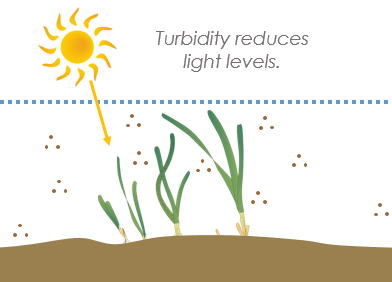
Eelgrass needs sufficient light to grow. Turbidity (a measurement of the cloudiness of water) can reduce the amount of light that is able to reach eelgrass underwater.
In Morro Bay, turbid water can be caused by sediment from the creeks that drain into the bay or from the ocean. The tide can also sweep up sediment from the mudflats, re-suspending it in the water column. This causes turbidity and reduced light levels.
Healthy eelgrass beds help hold sediment on the bottom of the bay. The extensive loss of eelgrass in Morro Bay means that the sediment on the bay bottom is free to move around, likely leading to more turbid conditions.
Dr. Ryan K. Walter, a researcher at Cal Poly, has been monitoring turbidity in the bay. Erin Aiello, who is now a doctoral candidate at the University of California Santa Cruz, collected pilot research on light availability within different parts of the bay during her Master’s studies at Cal Poly. Future posts in this series will explore their research.
Other water quality concerns
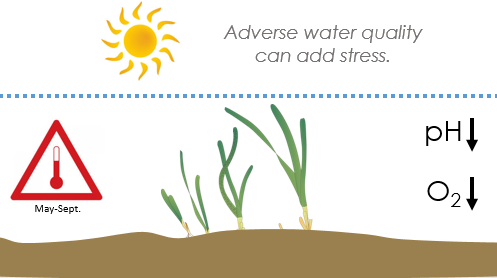
In addition to turbid water, eelgrass can also be affected by other problematic water quality conditions. Eelgrass can be stressed by prolonged periods of elevated temperatures, low pH, and low oxygen levels. Poor circulation patterns in the estuary can exacerbate these water quality problems, as water has limited mixing with incoming tides. Oxygen levels in the bay can fluctuate due to algae blooms.
Dr. Ryan K. Walter and Dr. Emily Bockman, researchers at Cal Poly, are currently monitoring these water quality parameters in the estuary.
Eelgrass wasting disease
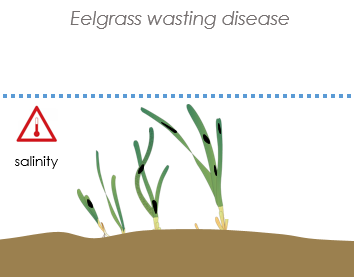
A marine slime mold (labyrinthula), often called eelgrass wasting disease, can invade stressed eelgrass leaves. It cause dark-colored lesions on the blades that reduce photosynthesis and can kill the plant. The slime mold can be present without causing harm to it, but problematic water quality conditions have been found to increase the virulence of the marine slime mold in other estuaries.
Dr. Laurie McConnico and Dr. Silvio Florento at Cuesta College have recently began studying the presence of the slime mold in Morro Bay. A future blog post will explore their ongoing research.
Competition for light with macroalgae
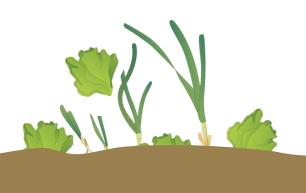
Macroalgae is what most people call seaweed. The term refers to large algae that can be seen with the naked eye. There are three types of macroalgae: green algae, red algae, and brown algae. We have all three types in Morro Bay.
- Sea lettuce, or ulva, is a green algae
- Sea moss, or gracilaria, is a red algae
- Giant kelp, or macrocystis, is a brown algae
While kelp tends to grow closer to the harbor mouth and in other areas outside of eelgrass beds, both ulva and gracilaria can grow on top of eelgrass. When this happens, the macroalgae competes with eelgrass for the sunlight that both organisms need to grow. The competition problem can be compounded when elevated nutrient levels in the water and higher water temperatures increase the growth of macroalgae.
Dessication
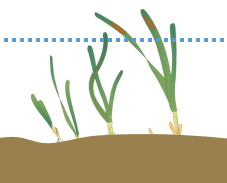
Eelgrass blades can dry out when they are exposed to the air and sunlight during very low tides or during a greater number of typical low tides. An increase in exposure to typical low tides can result from sediment buildup on the bay bottom. This increases the elevation at which the eelgrass grows, putting it above the low tide line.
A portion of the eelgrass that grows in Morro Bay is located in intertidal areas, which are naturally exposed at lower tides throughout the year. When growing in dense patches, eelgrass blades can help to keep each other moist at low tides, but once large patches have been lost, this benefit is diminished.
Smothering
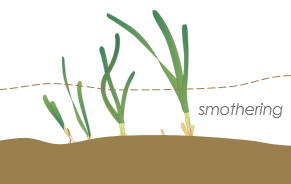
Eelgrass can also be directly buried by large changes in elevation. In 1996, Morro Bay saw a fairly significant decline in eelgrass after a large fire in the watershed followed by a heavy rain year delivered a large amount of sediment to the bay, smothering eelgrass. Research through California Sea Grant is underway to evaluate the change in estuary elevations over time. This study will help us better understand sediment dynamics and how they relate to eelgrass extent.
Low oxygen levels in soil
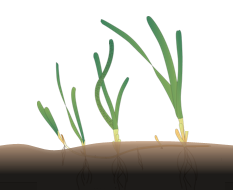
Anoxic soil (soil with low oxygen levels) can also impact the survival of eelgrass. Soil becomes anoxic when the rate of oxidation of organic matter by bacteria is greater than the supply of dissolved oxygen. In areas with large patches of eelgrass, the growth of eelgrass rhizomes (root-like structures) can help to keep oxygen in the sediment. Areas without large patches of eelgrass do not receive this benefit.
In addition to these physical factors that affect eelgrass growth, there are a number of biological and human factors that can affect this underwater grass. The next post in this series will explore these factors.
Help protect and restore the Morro Bay estuary
- Donate to the Estuary Program today and support our work in the field, the lab, and beyond.
The Estuary Program is a 501(c)3 nonprofit. We depend on funding from grants and generous donors to continue our work. - Support us by purchasing estuary-themed gear from ESTERO. This locally owned and operated company donates 20% of proceeds from its Estuary clothing line and 100% of Estuary decal proceeds to the Estuary Program. Thank you, ESTERO!
- Purchase items from the the Estuary Program’s store on Zazzle. Zazzle prints and ships your items, and the Estuary Program receives 10% of the proceeds. Choose from mugs, hats, t-shirts, and even fanny packs (they’re back!) with our fun Estuary Octopus design, our classic Estuary Program logo, or our Mutts for the Bay logo.
Thank you for your support!